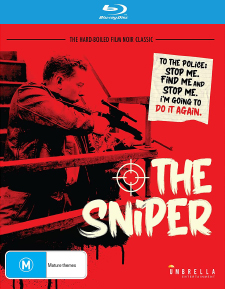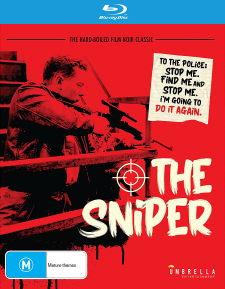Sniper, The (1952) (Blu-ray Review)

Director
Edward DmytrykRelease Date(s)
1952 (August 13, 2021)Studio(s)
Stanley Kramer Productions/Columbia Pictures (Umbrella Entertainment)- Film/Program Grade: B-
- Video Grade: B+
- Audio Grade: B-
- Extras Grade: B+
Review
[Editor’s Note: This is a REGION-FREE Blu-ray release.]
Nineteen years before a serial killer with a rifle terrorized San Francisco in Dirty Harry, a different killer did the same thing in Edward Dmytryk's 1952 film The Sniper. While the Scorpio of Dirty Harry was inspired by the real-world Zodiac, there's little doubt that director Don Siegel was also influenced by The Sniper. There had been a few isolated stories about serial killers such as Fritz Lang's M or Charlie Chaplin's Monsieur Verdoux, but it was Dmytryk's film which launched the modern subgenre which followed—Psycho, The Boston Strangler, and Dirty Harry all owe a debt to it.
The Sniper was a Stanley Kramer production, but the project was really driven by the husband-and-wife team of Edward and Edna Anhalt, who created the story and served as associate producers. The screenplay by Harry Brown splits its time between the killer and his hunters. Edward Miller (Arthur Franz) is a young man with a troubled past, whose hatred of women begins to express itself violently. When his cries for help are ignored, he takes action. The police have few clues at their disposal, but Lt. Frank Kafka (Adolph Menjou) leads the search while the media stokes the fears of the general public. The solid supporting cast includes Marie Windsor, Gerald Mohr, Richard Kiley, Lilian Bond, and the ubiquitous Charles Lane.
Edward Dmytryk was one of the Hollywood Ten who defied the House Un-American Activities Committee and went to jail for refusing to testify, but he later recanted and named names. The Sniper was the first film that he made after his release, and regardless of what he did to gain his freedom, he had lost none of his touch behind the camera. The film is lean and efficient, with a striking noir style, and it makes the most of location shooting in San Francisco. The only problematic element is the shallow presentation of the killer's psychology, but that was typical for the day—even Psycho couldn't escape it. Miller is an interesting character who deserved a more nuanced presentation than what he receives here, but that's a minor quibble for a film which remains very effective decades down the road.
Cinematographer Burnett Guffey captured The Sniper on 35 mm photochemical film, using spherical lenses, and framed at the 1.37:1 aspect ratio for its theatrical release. The grayscale looks excellent, with good contrast and black levels. Shadow detail can vary a bit, and blacks appear crushed in a few shots, but that’s likely how it was photographed—the stark, high-contrast look is deliberate. (On the other hand, a few of the brightest highlights do seem a little blown out, such as the keys on the piano played by Marie Windsor.) The image displays plenty of fine detail, with no signs of noise reduction, and only the tiniest bit of speckling here and there. The grain is even throughout, but the transfer occasionally has issues resolving it. Grain swims unnaturally in some areas of the screen, mixed with noise, especially on highlights such as shirt lapels, and also in bright backgrounds. The disc maintains a high bit rate throughout, so it doesn’t appear to be an encoding issue. But it’s a relatively minor problem for an otherwise fine transfer.
Audio is offered in English 2.0 Mono DTS-HD Master Audio, with no subtitles available. Fidelity is limited by the vintage source, but it sounds clean, and the dialogue is clear. George Antheil’s score sounds fine, and it supports the story well.
Umbrella’s Blu-ray release for The Sniper is labeled on the back as Region B, but like most of their discs, it’s actually Region-Free. The insert is reversible, but the only difference between the two sides is that one of them omits the mandatory Australian “M” classification on the front cover artwork. The following extras are included, all in HD upscaled from SD:
- Introduction by Martin Scorsese (3:18)
- Audio commentary by Author Eddie Muller
- Film Noir Trailer Collection (1:44:01)
- Original Theatrical Trailer (2:15)
In the introduction, Scorsese talks about how The Sniper always had a flat look to it, but with a real sense of place and an almost documentary feel. He also briefly examines the San Francisco settings, and the film’s outdated presentation of psychology. The commentary track is by Eddie Muller, a San Francisco native who has written multiple books on film noir, so he’s the perfect choice to talk about this film. He explains how Kramer produced the picture under the deal that he had with Harry Cohn at Columbia, where he was given freedom to make whatever films that he wished as long as they stayed under a $1 million dollar budget. Muller also discusses Dmytryk’s experiences with HUAC, and how surprising it was that the virulently anti-communist Adolph Menjou agreed to work with the director. He covers all of the other actors involved in the film as well, and spends time pointing out the locations and the film’s sometimes creative presentation of geography. He also tells the story of a would-be copycat killer who was inspired by the film, and while no one died, it led to an unsuccessful class-action lawsuit against Columbia Pictures. Muller clearly knows his subject well, and the whole track is filled with interesting details and anecdotes. The Film Noir Trailer Collection is a feature-length compilation of trailers from 42 different films, some of which may stretch the boundaries of what can be called film noir, but it’s always been a term with a nebulous definition anyway. Titles include Crossfire, The Big Sleep, The Lady in the Lake, The Postman Always Rings Twice, Double Indemnity, The Big Heat, The Ministry of Fear, I Am a Fugitive from a Chain Gang, The Killing, The Night of the Hunter, Key Largo, Kiss Me Deadly, and many, many more. It’s an impressive collection, and a fun reminder of the lost art of creating trailers which don’t simply rely on clips from the films.
The following extras from the Region B Powerhouse Indicator Series Blu-ray are not included here: the short subjects Three Lives and Three Pests in a Mess, as well as an image gallery. Powerhouse offered it as a part of their Columbia Noir #3 collection and also as a standalone release which included a 120-page booklet filled with essays and photographs, which aren’t reproduced in Umbrella’s version. All things considered, losing the shorts and the image gallery in favor of the comprehensive collection of trailers and the Region-Free encoding gives this Umbrella disc the edge.
However influential The Sniper may have been, it ended up being overshadowed by the serial killer films which followed, and it’s not very well-remembered today. It’s interesting to see how it set the template for many of those other films, and also the ways in which it followed its own path—simplistic psychology or not, it’s far more sympathetic to the plight of its killer than films like Dirty Harry were. Umbrella’s Blu-ray package is a good way to learn more about this neglected film.
- Stephen Bjork
(You can follow Stephen on Facebook at this link)

